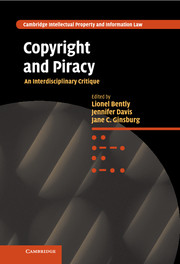Book contents
- Frontmatter
- Contents
- Notes on the contributors
- Editors' preface
- Table of cases
- Table of statutes
- Part I Introduction
- Part II History
- Part III Comparative Law
- Part IV Economics
- Part V Linguistics
- Part VI Computer software
- 10 Copyright, piracy and software
- 11 Of plots, puddings and draught-excluders: the law as it applies to the infringement of computer programs
- Part VII Information studies
- Part VIII Literature
- Part IX Art
- Part X Sociology/music
- Part XI Criminology
- Bibliography
- Index
10 - Copyright, piracy and software
from Part VI - Computer software
Published online by Cambridge University Press: 17 November 2010
- Frontmatter
- Contents
- Notes on the contributors
- Editors' preface
- Table of cases
- Table of statutes
- Part I Introduction
- Part II History
- Part III Comparative Law
- Part IV Economics
- Part V Linguistics
- Part VI Computer software
- 10 Copyright, piracy and software
- 11 Of plots, puddings and draught-excluders: the law as it applies to the infringement of computer programs
- Part VII Information studies
- Part VIII Literature
- Part IX Art
- Part X Sociology/music
- Part XI Criminology
- Bibliography
- Index
Summary
Software is the output of creative efforts by programmers, which differs in a number of ways from other protected works. In this chapter, I will discuss the technical and cultural differences between software and other works that may be protected by copyright or intellectual property more generally, and will thereby endeavour to demonstrate that concepts of infringement which may apply to other works do not readily transpose to software.
I try to show those characteristics of software which differ significantly from other works sufficiently to justify at least a significant review of the types and scope of protection that should be provided legally, economically and technologically. Most of these differences in characteristics are quantitative, and can be captured in the idea that software has transient value, and is always evolving to improve based on past use, and to meet new needs of old and new users. This impermanence means that software is almost always a ‘work-in-progress’, rather than a finished product. The process of that progress may be more important (in terms of creativity, invested effort and value, worth protecting) than any particular ‘snapshot’ of the software at any particular moment. Against this background, novel approaches to ownership and enforcement have emerged, such as open source, as well as copyleft. These have been accompanied by novel business models for recovering costs and making money from the generation of software goods and services.
- Type
- Chapter
- Information
- Copyright and PiracyAn Interdisciplinary Critique, pp. 209 - 229Publisher: Cambridge University PressPrint publication year: 2010

